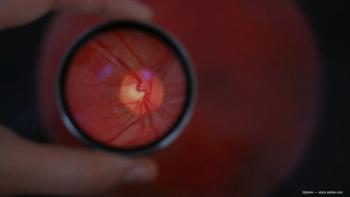
Managing ocular surface disease in patients with glaucoma
Treating ocular surface disease may have an impact on the effectiveness of glaucoma treatment. Inder Paul Singh, MD, offers some strategies used in practice.
By Inder Paul Singh, MD, Special to Ophthalmology Times
Ocular surface disease (OSD) is an extremely common entity, so it should be no surprise that it can frequently be found in patients with glaucoma.
Ocular surface disease index (OSDI) scores are normal in about 41% of patients with glaucoma, demonstrate mild to moderate dry eye disease (DED) in about 33%, and severe dry eye in 26%.1
Related:
A study by Rossi and colleagues reviewing tear break up time (TBUT), corneal staining, and OSDI scores in patients with glaucoma grouped patients into four categories.2 Five percent of those on zero medications had DED; 11% on one medication had DED; 39% on two medications had DED; and 40% of those on three medications had DED.
The conclusion is obvious: The more medications that patients take, the more likely it is for patients to complain or exhibit signs of dry eye.
OSD can negatively impact quality of life and cause significant visual symptoms, with the potential to impact both the quantity and quality of patients’ vision. There are many similarities in the characteristics of patients affected by either OSD or glaucoma-for example, older age, postmenopausal status among women, and presence of comorbidities for which systemic medications are needed. Of course, both OSD and glaucoma are progressive and chronic conditions, and so for each, earlier treatment usually portends better outcomes.
More:
Importantly, OSD can be both an instigator for and reason why patients are less than optimally compliant with medical therapy-leaving aside that untreated OSD can also potentially slow down healing after incisional surgeries, leaving patients at risk for discomfort and compromised vision.
Compliance with medical therapy is a multifactorial and difficult problem in glaucoma, although one of the most common reasons patients fail to apply topical therapies is due to associated ocular discomfort.
Recent:
The tearing, burning, fluctuating vision, pain, redness, and other symptoms associated with OSD are more readily apparent than glaucoma symptoms, and, thus patients may become concerned with the immediate cause of their visual symptoms and incorrectly attribute them to a side effect of the medication.
As well, visual symptoms secondary to OSD can be exacerbated by certain glaucoma medications, especially if they contain preservatives, and the compound effect is a situation where patients are extremely uncomfortable and unwilling to instill drops.
Patients with glaucoma, if they are being medically managed, are typically going to be on topical therapy for a long period to treat their chronic condition.
Related:
Therefore, the approach to therapy should be as minimally invasive to the ocular surface as possible, irrespective of whether OSD is present. If OSD is present, it should be mitigated early on to reduce the potential for it to impact on the treatment of the glaucoma.
There are some parallels we may be able to learn from in the current thinking surrounding OSD in cataract patients, where minimally invasive approaches are preferred to minimize induced trauma to the ocular surface.
Likewise, when devising treatment strategies in glaucoma patients, there is rationale for considering options that are minimally invasive so that the planned treatment does not cause undo stress or damage to the rest of the eye.
A proactive approach
In our clinic, roughly 75% to 80% of patients with glaucoma have comorbid OSD. As a result, every new patient is started with the OSDI questionnaire. Patients identified as needing additional work-up are evaluated with fluorescein and lissamine stain staining.
The clinical also utilizes other diagnostic tools, such as objective TBUT using an advanced corneal topographer with built-in keratometer/color camera optimized for external imaging (Keratograph, Oculus); a rapid, in-office test for inflammatory dry eye (InflammaDry, RPS); and a point-of-care diagnostic test to measure the osmolarity of human tears (TearLab Osmolarity System, TearLab Corp.), depending on the situation. InflammaDry is an index of MMP-9 activity on the ocular surface, and thus serves as a marker of inflammatory activity. The latter is performed to get a baseline assessment to help gauge the severity of the dry eye and to have something to compare with over time and to assess the effectiveness of our interventions.
More:
Overall, we use diagnostic testing to tailor our approach to treatment, but rely heavily on symptoms.
This proactive approach extends to treatment, where we tend to be aggressive in initiating interventions for OSD, with the rationale that if the symptom reports are indicative, it is better to start treatment even in the absence of diagnostic certainty.
Artificial tears and cyclosporine 0.05% (Restasis, Allergan) are fairly innocuous and are not associated with significant side effects, and so, in my mind, the risk-benefit ratio tips in favor of earlier treatment to quell potentially progressive and chronic OSD. A new prescription eye drop to treat the signs and symptoms of dry eye disease,
Related:
Treating OSD may have an impact on the effectiveness of glaucoma treatment. We conducted an informal study in 20 patients who were on multiple medications (average of 2.5 medications) and who had OSDI scores indicating moderate to severe DED. We took these patients off glaucoma drops and treated the DED with tears, cyclosporine 0.05% and other modalities as needed. After OSDI scores improved, we then them put them back on glaucoma therapy.
After treating the OSD, greater than 50% of patients were maintained at their target pressure with a single medication. This may be due to a large impact of DED on medication compliance.
When planning glaucoma therapy in the presence of known OSD, there is strong rationale to avoid agents that contain preservatives or that can irritate the ocular surface. Yet, even in patients without known OSD, it makes sense to minimize the impact on the ocular surface whenever possible. Signs and symptoms of OSD do not always correlate-patients may not know they have OSD or else may develop it over the course of follow-up.
I have used BAK-containing glaucoma medications for years. Though BAK has been shown to be a safe, effective preservative both in studies and in our practice, there has been a push to remove as much BAK as possible from medications that are used for an extended period. There are currently two BAK-free prostaglandin formulations on the U.S. market: travoprost 0.004% (Travatan Z, Alcon Laboratories) and tafluprost ophthalmic solution 0.0015% (Zioptan, Akorn).
More:
Although travoprost 0.004% is BAK-free, it does contain a preservative. It also has a lower pH compared with the BAK-containing formulation.
Studies are mixed in terms of the clinical effects of BAK on the ocular surface. In one study, patients switched from BAK-containing latanoprost 0.005% (Xalatan, Pfizer) to travoprost 0.004% exhibited improvements in OSDI scores.3
However, by the end of the study, there was no difference in the mean change in OSDI score from baseline to week 12 between patients switched to travoprost 0.004% and those who stayed on latanoprost 0.005%.
Another study by Whitson et al.4 assessed TBUT, hyperemia, and corneal staining of patients on brand name Xalatan who were then randomly assigned to receive either bimatoprost ophthalmic solution 0.01% (Lumigan, Allergan), travoprost 0.004%, or to be continued on Xalatan. Patients and investigators were both masked. At 3 months, no statistically significant differences were observed among PGAs with respect to hyperemia, corneal staining, or TBUT.
Related:
Hannu Uusitalo published a study in Acta Ophthalmologica in 20105 looking at whether patients who had ocular surface disorders during their treatment with latanoprost benefited by changing to preservative-free tafluprost.
Patients were switched from latanoprost to preservative-free tafluprost and treated for 12 weeks. The number of patients experiencing forms of irritation, burning, or stinging decreased during treatment. The number of patients with abnormal fluorescein staining of the cornea was reduced from 81.6% to 40.6%; those with conjunctival staining dropped from 84.2% to 43.2%; and rates of blepharitis (60.1% to 40.6%), conjunctival hyperemia (84.2% to 60%) and abnormal Schirmer test scores (71.5% to 59.4%) also declined.
TBUT increased from 4.5 ± 2.5 seconds to 7.8 ± 4.9 seconds. The number of patients with abnormal conjunctival cells based on HLA-DR and MUC5AC was also reduced.
Another prostaglandin in late-stage development, latanoprost 0.005% (Xelpros, Sun Ophthalmics), is formulated with a swollen micelle microemulsion to solubilize the drug, thus eliminating the need for benzalkonium chloride.
Conclusion
Despite its potential to be a confounding factor in the treatment of glaucoma, OSD is an underappreciated and, perhaps, undertreated entity in this population of patients.
The PHACO study demonstrated that around 80% of patients are referred for a cataract consultation with unknown dry eye symptoms.6
I would argue there may be a similar scenario with glaucoma patients as far as undiagnosed OSD. In an era where diagnostic tools have become powerful and specific for detecting the signs of OSD, and in an age when patients are becoming increasingly aware of the symptoms, awareness is increasing about how comorbid OSD and glaucoma may influence one another.
Taking a proactive approach to diagnosing and treating OSD and initiating glaucoma interventions that are minimally invasive to the ocular surface has every potential to lead to more positive outcomes for patients.
Related:
References
1. Leung EW, Medeiros FA, Weinreb RN. Prevalence of ocular surface disease in glaucoma patients. J Glaucoma. 2008;17:5:350-355.
2. Rossi GC, Tinelli C, Pasinetti GM, et al. Dry eye syndrome-related quality of life in glaucoma patients. Eur J Ophthalmol. 2009;19:4:572-579.
3. Katz G, Springs CL, Craven ER, Montecchi-Palmer M. Ocular surface disease in patients with glaucoma or ocular hypertension treated with either BAK-preserved latanoprost or BAK-free travoprost. Clin Ophthalmol. 2010;4:1253-1261.
4. Whitson JT, Trattler WB, Matossian C, et al. Ocular surface tolerability of prostaglandin analogs in patients with glaucoma or ocular hypertension. J Ocul Pharmacol Ther. 2010;26:287-292.
5. Uusitalo H, Chen E, Pfeiffer N, Brignole-Baudouin F, Kaarniranta K, Leino M, Puska P, Palmgren E, Hamacher T, Hofmann G, Petzold G, Richter U, Riedel T, Winter M, Ropo A. Switching from a preserved to a preservative-free prostaglandin preparation in topical glaucoma medication. Acta Ophthalmol. 2010;88:329-336.
6. Trattler W, Reilly C, Goldberg D, Majmudar P, Vukich J, Packer M, Donnenfeld E. Cataract and dry eye: Prospective Health Assessment of Cataract Patients’ Ocular Surface Study. Poster, American Society of Cataract and Refractive Surgery Annual Symposium and Congress. San Diego; March 2011.
Inder Paul Singh, MD
Dr. Singh is president of The Eye Centers of Racine and Kenosha, WI. He declares financial interest with Alcon Laboratories, Allergan, Bausch + Lomb, Glaukos, Inotek, Ivantis, Ocular Therapeutix, and Sun Ophthalmics.
Newsletter
Don’t miss out—get Ophthalmology Times updates on the latest clinical advancements and expert interviews, straight to your inbox.








































